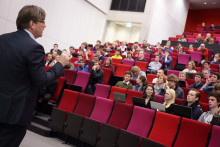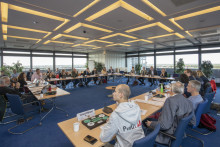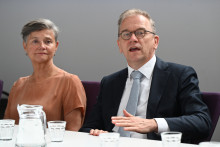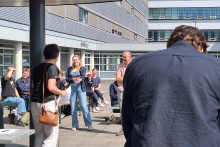The 26-year-old researcher, Yanbo Xie, hails from the ancient city of X’an, nestled in the Xi Province in China, a place long-known for its Terracotta Warriors built by a Chinese emperor around 100 BC. Xie grew up in a typical Chinese family where both his parents worked. His father is an interior decorator who focuses on traditional Chinese art, crafting tables out of wood and the bones of animals, and his mother works for the railway.
The young physicist, in his first year of his PhD program, wants to further research the possibilities of being able to produce the most energy by increasing streaming potential on the surface of a chip and through the use of the latest nanotechnologies.
His studies are based on the fundamental theory that when salt water fills in a tube if the surface is negatively charged then a thin layer of electrical charge exists on the tube wall. When using external pressure to make the water flow, the charges move with the water molecules and can produce electrical signals. His main objective is to discover a way to convert the hydrodynamic energy to electrical energy. Ultimately, he says, ‘My research task is to work on developing the fluidic device. Basically, we are trying to enhance the scanning capability of a battery to maximize the output power and efficiency.’
The future development of an efficient nano- or micro-battery, one built with newly developed devices, could be used in applications and situation where a novel energy source enhances the capabilities of an end product. Though reluctant to forecast the potential of this new energy source, the soft-spoken Xie, hesitated to add, ‘If your watch battery is dead, I could imagine being able to quickly press a button and it would recharge, and the same could apply to a mobile phone. One general aim of the research is to find ways to increase the output power then maybe we can also apply the devices to be used for lights and cars.’
Taking into consideration the push towards producing sustainable products, he says, many of today’s scientists are actively exploring the hidden potential of generating new electrical power sources with the use of nano-or micro-devices which can offer less harm to the milieu, reduce costs, and minimize the impact on the environment, lessening the harmful waste produced by battery acids.
Most of Xie’s friends back in China, who graduated from Peking University where he earned a master’s degree in physics, went to study at the top-notch technical universities in the US, yet he says the draw to Enschede was for good reasons. ‘My research group is renowned. It is famous in the world. We have fun and make jokes. My supervisor Jan Eijkel is a funny guy and smart. He helps me to really focus on my research project.’ Breaking out on top, the BIOS-Lab-on-a-Chip group could easily be labeled an ‘international powerhouse in nanotechnology’ and specializes in miniaturized systems for biomedical and environmental applications. Led by Albert van den Berg, who last year received the prestigious Spinoza Award, garnering a staggering 2.5 million euros, the money will be spent in a profitable way to further scientific research.
On the weekends, he finds time to relax by playing badminton with some of his Chinese friends or soccer matches during the week with fellow researchers in his group. ‘There are around 200 members in the Chinese Student Association in Enschede,’ says Xie, and most of them cook their own food and avoid the lunches offered on campus. ‘Dutch food is cooked in a different way.’ He grins and predicts, ‘Maybe at the end of my PhD program, I’ll be eating sandwiches every day like the Dutch.’ Treading on the path to new discoveries in his field, Xie plans to later continue in the area of microfludity in a post doctoral position, and in due course return to his beloved homeland in China.
 |
| Stab in the dark for new energy source: In the dark, small lab room in the Horst building Yanbo Xie holds a plastic container in his hands, showing the tiny devices that are now changing the world. ‘My task is to make the fluidic device more efficient and be able to produce a higher output power.’ (Photo: Gijs van Ouwerkerk) |







